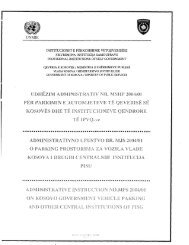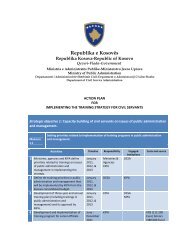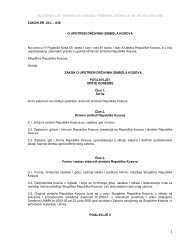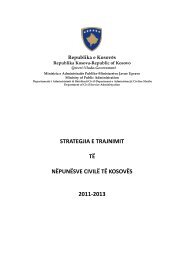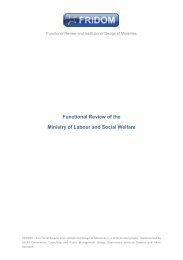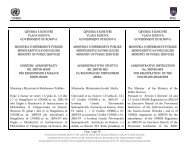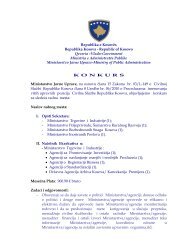Download
Download
Download
Create successful ePaper yourself
Turn your PDF publications into a flip-book with our unique Google optimized e-Paper software.
5. There are many constraints on making these changes that need to be dealt with at the<br />
government level. The working arrangements and structure of the Ministry has evolved in<br />
response to issues such as:<br />
Current governance and accountability framework for the hospitals and other agencies<br />
that are not creating sufficient incentives for performance.<br />
Method of setting pay levels which provide incentives to create divisions, centres, and<br />
agencies.<br />
Incentives for doctors and other technically skilled staff to be managers to get into the<br />
higher paid management positions. This reduces breadth of other skills at senior levels.<br />
There is insufficient recognition in the civil service classifications and pay scales of the<br />
value of technicians in the public sector compared to managers. The draft Civil Service<br />
Law and the proposed Law on Salaries continue these problems.<br />
Government-wide administrative instructions that require a legal department, an<br />
information department, and other government requirements such as the European<br />
Integration Office and the Gender, Human Rights and Quality office. These instructions<br />
specify positions and staffing but a “one size fits all” approach is not suitable for all<br />
ministries.<br />
Frequent changes of senior leaders. There have been four ministers and six PSs since<br />
2002, with three changes in PSs in the past year. The current PS is acting in the role.<br />
Some key departments have acting directors.<br />
Funding decisions by the government. In some areas there has been insufficient<br />
investment to support critical changes and improvements.<br />
Rigidities in the allocation and management of finances that make it difficult for health<br />
institutions to manage effectively (see World Bank report’s comments on hospitals in<br />
Appendix D). 1<br />
6. Changes need to be sequenced in a way that will build on current capabilities without<br />
putting the organisation at risk of failing at its key roles during the changes. The<br />
organisational arrangements and structure are the way they are in response to the<br />
environment. If changes are forced without dealing with the barriers mentioned earlier, there<br />
will be unintended consequences, such as losing key people. Best practice ideas could be<br />
bad practice if the constraints affecting the MOH are not addressed. The reforms must be<br />
designed to deal with the unique conditions in Kosovo and not simply transport models from<br />
other countries. While there are many valuable lessons from other countries, the best<br />
design will be the one that fully taps into the potential for rapid development, given the<br />
situation in Kosovo.<br />
Recommendations for the short term- next three months<br />
1. Develop a process to consider the reform options for MOH functions, structure,<br />
systems, processes, staffing and culture with a timeline for analysis and decision<br />
making, resulting in the production of the Institutional Development Plan. As part of this<br />
process, consider the options and variations presented in this report alongside others that<br />
may emerge from the internal work on the reform options. If possible, conclude this plan<br />
within three months and start implementing it as soon as possible.<br />
2. Contribute to the policy and preparation of the changes to the laws on civil service,<br />
labour and pay to address the potential problems emerging in these draft laws, including<br />
the civil service job classifications; the pay mechanism; and the implications for workers in<br />
the wider health sector who will not be civil servants. Consider if there are opportunities to<br />
influence the law and policies impeding good design for the MOH relating to the form of<br />
1 World Bank, “Kosovo Health Financing Reform Study”, page 11.<br />
5



